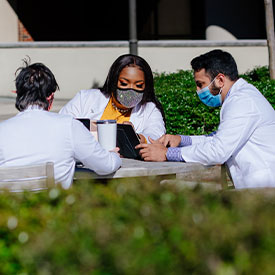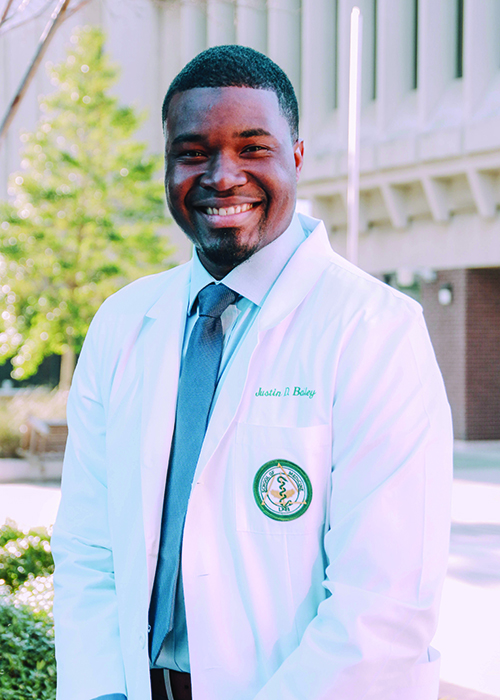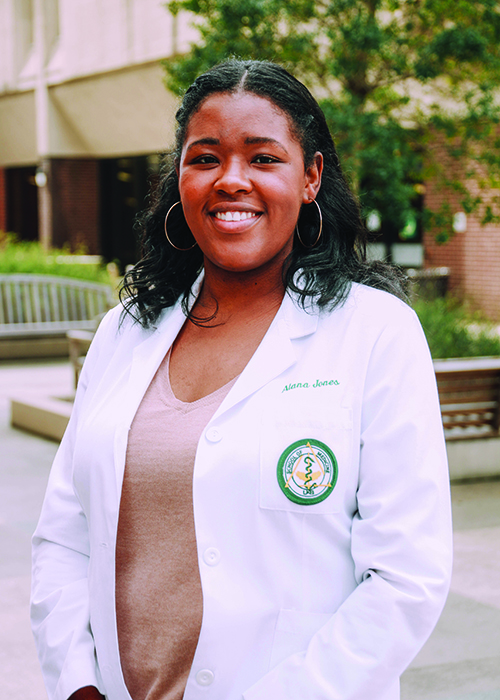 A key element of the UAB School of Medicine’s mission is to expand Alabama’s physician workforce. Recruiting a more inclusive and diverse student body is an important part of our strategy to achieve this goal. Embracing different perspectives, backgrounds, and experiences not only enriches the learning environment; a more diverse physician workforce has the power to expand access to care and improve health.
A key element of the UAB School of Medicine’s mission is to expand Alabama’s physician workforce. Recruiting a more inclusive and diverse student body is an important part of our strategy to achieve this goal. Embracing different perspectives, backgrounds, and experiences not only enriches the learning environment; a more diverse physician workforce has the power to expand access to care and improve health.
The UAB School of Medicine and the Medical Alumni Association have partnered on an initiative designed to recruit and support medical students from backgrounds considered underrepresented in medicine (URiM), which the Association of American Medical Colleges defines as “racial and ethnic populations that are underrepresented in the medical profession relative to their numbers in the general population.” At the School of Medicine, the term also includes students from rural areas. Here we profile three medical students from URiM backgrounds who exemplify why our commitment to diversity promotes excellence as much as equity.
Rural Reflections
A native of Hamilton, Alabama, Emily Brown is a true pipeline success story. As a high school senior, Brown was accepted into the Rural Health Scholars (RHS) program, a program of The University of Alabama’s College of Community Health Sciences that provides students with opportunities to pursue health care careers. Inspired by her own family medicine practitioner, Brown saw the barriers and lack of accessibility to modern equipment firsthand as an adolescent.
“When I was a high school student, I had an emergency and was taken to the local emergency room. The doctor looked at my mom and said, ‘I can’t take care of her here. I wish I could, but I do not have what I need.’ So I was airlifted to Birmingham. The doctor truly did everything he could to help and it was obvious that he cared. But, from that experience, I know personally that one of the biggest barriers in rural health is distance from big city resources and having access to modernized technology.”
In college, Brown became a counselor for the younger Rural Health Scholars. After graduating from The University of Alabama (UA), Brown joined the Rural Medical Scholars Program (RMSP), a partnership between and the UAB School of Medicine and UA’s College of Community Health Sciences. The RMSP was created to address the shortage of primary care physicians in Alabama’s rural areas by recruiting and supporting rural Alabama college students who want to become physicians and practice in rural communities. Now, as a rising MS3 and a Rural Medical Scholar, Brown has the opportunity to work hands-on in primary care settings. The program allows students to participate in integrative curriculums for six months, instead of typical four-week rotations.
“This option is exciting because it gives medical students an opportunity to build relationships early in their education, and get to know patients,” Brown says. “I saw the same family physician from the time I was in kindergarten to adulthood, and was actually able to shadow in his clinic in undergrad. He knew who I was, and knew things about me other than my name.”
Brown is also involved in the Alabama Rural Health Association, and acts as treasurer for the UAB chapter. “I want to help other medical students see the positives in rural health,” she says. “I’d also like to help other schools at UAB get involved in rural health programs to increase awareness about rural providers’ and patients’ needs.”
Brown says her passion and future goals are to connect residents in rural areas to the health care they need. She hopes to eventually practice in a smaller, rural location, “somewhere that doesn’t have access to bigger city resources.”
She’s interested in primary care specifically because of the unique relationships physicians have with patients. “Rural care is very different from other care. Physicians in these areas may not have access to the most advanced technology or tools, so there’s an ongoing challenge. But on the other hand, a benefit of rural care is the strong relationships between patients and doctors.”
A Second Chance to Help Children
Justin Bailey has a passion for helping children thrive. While working his first career as a teacher, Bailey found fulfillment in helping his students meet their goals. But it was not long before he started seeing troubling trends—that no matter what he did in the classroom, some students struggled with factors outside of school that affected them negatively in many ways, including their academic performance.
 Justin Bailey, M.D. student“One big thing that kept coming up was socioeconomic status and health care—either in access to see a doctor or ability to afford it,” he says, adding that some students’ parents had multiple jobs, leaving them with the responsibility to watch their younger siblings, which created another barrier to seeing their doctor regularly.
Justin Bailey, M.D. student“One big thing that kept coming up was socioeconomic status and health care—either in access to see a doctor or ability to afford it,” he says, adding that some students’ parents had multiple jobs, leaving them with the responsibility to watch their younger siblings, which created another barrier to seeing their doctor regularly.
Bailey reached a point when he considered what his next career chapter should be and how to make a bigger difference in children’s lives. “I remember being very frustrated that I only saw kids from sixth grade to eighth grade,” he says. “Whatever happened to them in their lives before that time, and whatever happened after they were my student, I had no impact.
“I was really trying to figure out where I could have more reach. I wanted to do something where I could use my interests in teaching, science, and math to be able to reach these kids.”
Bailey enrolled at UAB to take post-baccalaureate courses to prepare to apply for medical school. Now, at 30 years old, Bailey will graduate from the School of Medicine in the spring of 2021.
This past year, Bailey was selected as one of 10 medical students to receive the Paul W. Burleson, M.D. Scholarship, which covered the cost of attendance for his fourth year. He said receiving the scholarship meant a great deal to him and his family.
“I was honestly surprised and extremely ecstatic to get this scholarship,” he says. “It goes so far to support my education. I’m 30, medicine is technically a second career for me and I had a life in between.”
During his time as a medical student, Bailey says he never stopped teaching. He volunteered his time for health education initiatives, like talking about healthy eating and how bodies work to children at the YMCA, teaching high school students about coronary artery disease through Camp Cardiac, and helping adults learn more about their health through disease screenings.
“I always love when I’m able to take some complex medical jargon or disease process and break it down so a fifth grader or a kindergartener can understand,” he says. “I’ve found that’s a skill that actually helped me in med school, because if I can do that, then I really understand the concept myself. If I’m just using all the textbook words, then I’m just regurgitating facts, but if I can break it down so my patients understand, then I really know it.”
He added that this skill will help him in his residency and career as a pediatrician because he can talk directly to his patients (and their parents) about diseases and treatments to help them manage their health.
Necessary Conversations
Born in Waverly, Alabama, Alana Jones is breaking barriers advocating for issues of race in medicine and creating strategies around student advocacy. An M.D./Ph.D. student, Jones’ professional interests center on biological mechanisms of health disparities. With her childhood and adolescence rooted in a rural town, she learned firsthand the realities of health, education, and environmental inequities in rural regions.
 Alana Jones, M.D./Ph.D. studentIn November 2020, Jones organized the Forum on Race Advocacy and Medical Education (FRAME) Conference, which explored topics of race and advocacy in medical education. She organized the conference with Christina Amutah, Jones’ peer and friend at Howard University—both share interests in health disparities, social determinants of health, and race in medicine.
Alana Jones, M.D./Ph.D. studentIn November 2020, Jones organized the Forum on Race Advocacy and Medical Education (FRAME) Conference, which explored topics of race and advocacy in medical education. She organized the conference with Christina Amutah, Jones’ peer and friend at Howard University—both share interests in health disparities, social determinants of health, and race in medicine.
“My colleague and I were following a similar path in college,” Jones says. “And in the beginning of the COVID-19 pandemic, we came back together to host a virtual conference to discuss topics with the public that we had been talking about for years between ourselves.”
The idea for FRAME began in 2020. Jones says she knew it was the right time to take her advocacy to the next level after seeing misinformation on social media and in the news about why people of color are disproportionately affected by COVID-19, as well as events surrounding the deaths of George Floyd, Breonna Taylor, and too many others.
The goal of the conference, which was open to students, trainees, and faculty, was to have a conversation with experts about issues that impact people of color in medicine—both on the provider and student sides. Amutah and Jones also aimed to create a space for members of the medical community to discuss the harmful ways that race is used in medicine and medical education, while developing long-lasting strategies for change.
The conference was highly successful with around 160 people attending. Jones was proud to see people commit three hours of their time on a Saturday to engage with the conference. “During this time of Zoom fatigue, the high attendance speaks into how important these issues are to students and other medical professionals,” she says.
“I am excited for the future of medicine because I see my classmates and the people who attended FRAME, and I know these are the future providers and educators for the next generation. I am excited to see people who are not afraid, in many ways, of saying something that someone may not like, but saying it because it’s the right thing.”
Jones says several people have asked about turning FRAME into an annual conference, and adding a research segment to the next FRAME conference. “I think within some of our existing conferences (beyond FRAME) we can set aside time to talk about race issues and network. We should have more meetings like this—we need to be having these conversations regularly.”
Jones is currently studying environmental differences in outcomes associated with cardiovascular disease. Her long-term research interests involve gene-environment interactions and elucidating the socio-epigenetic mechanisms of health disparities in chronic disease.
To learn more about the School of Medicine/Medical Alumni Association URiM Initiative, or to support URiM scholarships, including the new Excellence Through Equity Endowed Medical Scholarship, contact Erica Hollins at 205-910-2251 or ehollins@uab.edu, or make a gift online at go.uab.edu/excellencethroughequityscholarship. All gifts to URiM scholarships received through September 30, 2021, are being matched by the School of Medicine Dean’s Office 1:1. ~ Mary Ashley Canevaro and Kendra Carter